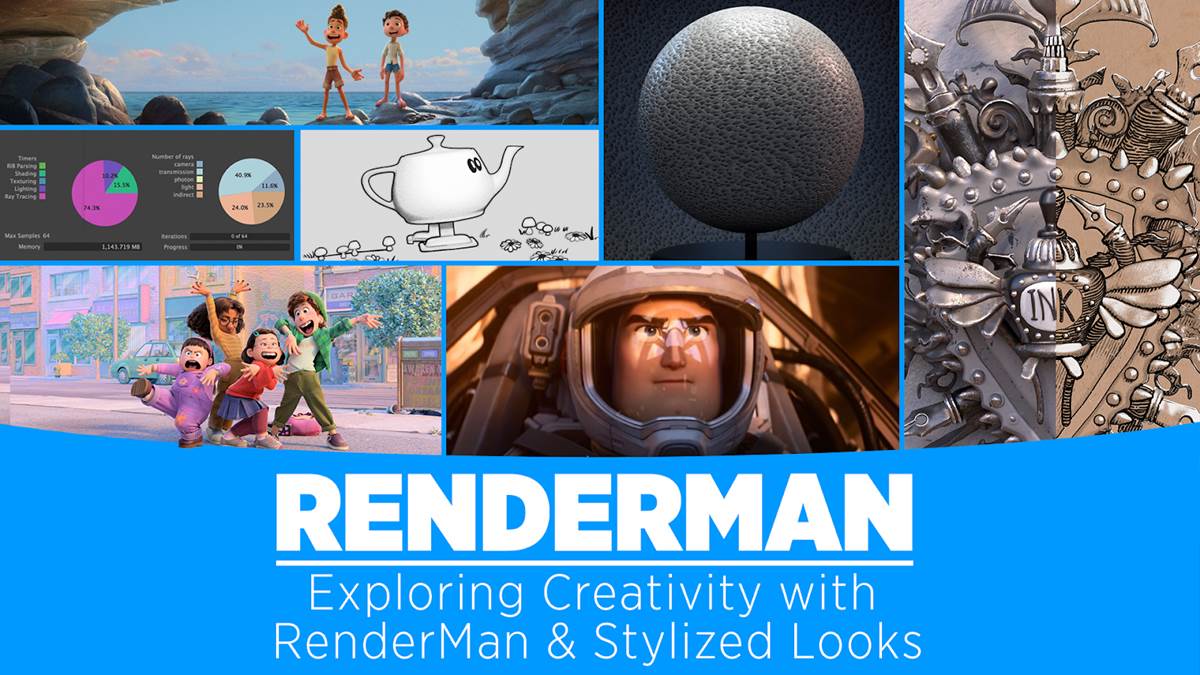Annecy 2022 Recap: Pixar’s Dylan Sisson Showcases New Functionality in RenderMan that Helped Make Recent Hits Like “Lightyear,” Turning Red,” “Soul,” and “Luca”
I’m not an animator, but I love animation, which is why I was excited to attend a panel at Annecy Festival by Dylan Sisson from Pixar Animation Studios called “Exploring Creativity with RenderMan." The homegrown software Pixar uses on their films and shorts is commercially available and in this panel, aimed primarily at animation students, Dylan showcased some of the system’s capabilities and some recent upgrades that may find their way into a future release. Two such presentations were offered, but due to timing constraints, I was only able to attend the first. This is a recap of the first presentation, held on Wednesday, June 15th.

(Pixar)
Dylan Sisson is famous within the animation community for his walking teapots, not only used for animation demos but also given away as three-dimensional wind-up toys (he brought a few to give away during a Q&A at the end of the panel). Dylan debuted a new short made with RenderMan and starring his teapot character, titled “Teapot Meets Potzilla" (an homage to Marv Newland’s cult classic Bambi Meets Godzilla). The short showcased a new RenderMan feature, the ability to render CG objects as 2D drawings. If the short didn’t swipe away the effect routinely to show the CG characters behind it, I would’ve sworn it was hand-drawn. Programmed into the code are hand-drawn variance of the lines, giving the illusion that they are changing in thickness from frame to frame as they would if drawn by hand. Noise was added to the short to replicate the filmic quality of Bambi Meets Godzilla. Dylan also showed off the tool’s ability to replicate the hand-drawn look through 6 images, 3 or which he drew by hand, 3 of which were CG builds rendered with this technique. I’m not going to lie, it was hard to tell the difference.
The presentation was broken into three parts after that amazing introduction, the first touching on RenderMan’s recent innovations at Pixar. In Lightyear, now playing in theaters, an artificial intelligence denoiser was applied to every pixel in the film, developed by Disney Research in Zurich, which allows images to be rendered 40% faster. The souls in Soul are stylized volumes (like clouds), which required the RenderMan team to break the code in order to render and shade them. For Toy Story 4, the entire world the film takes place in was developed in such a way that multiple artists could work on the same file at once without overloading the system. RenderMan’s renderer had to be extended for Coco, with Miguel and Dante’s arrival in the Land of the Dead features over 8 million individual lights (9 lights per pixel), which are currently available in the commercial version of RenderMan. The latest release, RenderMan 24, includes a new rendering process called XPU and Dylan showed a side-by-side comparison of a sequence from Luca, which would take 1 hour and 16 minutes with the previous RIS process, but now takes just 7 minutes through XPU.
Speaking of Luca, the second part of the presentation was all about the stylization of that film and how RenderMan made director Enrico Casarosa’s vision possible. RenderMan is more than capable of producing photorealistic water, but the stylized world of Luca required breaking those rules. The director’s artwork included stylized ovals in the seafoam and Dylan showed off some animation tests as well as a comparison of the seafoam in the short film Piper alongside the way it looks in Luca. They also had to change the way light behaves in the film, an example being a shot that follows Luca as he swims to the short and rises above the surface. In reality, you would see the ocean floor mirrored on the surface of the water, but the behavior of light was changed so that Alberto could be seen on the shore waiting for Luca. Shadows were another modification made, with shadow fringe modified to match the artist’s drawings.
The final part of the presentation was about artistic stylization at Pixar. Dylan used Turning Red to showcase RenderMan’s capabilities. A stylized light rig was created that created three levels of detail disparity in the stylized world, allowing director Domee Shi to have three levels of focus in shots, softening background elements as needed.
RenderMan is commercially available and includes plugins for popular animation software, including Blender, Houdini, Katana, and Maya. A no-cost version can be downloaded for non-commercial use, which includes student films that won’t yield revenue. Pixar is also able to extend a floating license to animation students who have graduated but want to continue an in-progress student film. Online resources are available free of charge to learn how to take full advantage of RenderMan’s software. Pixar hosts RenderMan challenges, through which projects can be submitted. Winners of the competition earn prizes and some have even been offered jobs or mentorships at Pixar Animation Studios. The software is currently being used by many animation studios that produce animated films, video games, and visual effects for live-action films, including Industrial Light and Magic, Blizzard, Laika, and more.
Click here for more coverage from Annecy Festival. Visit renderman.pixar.com to learn more about this software.


